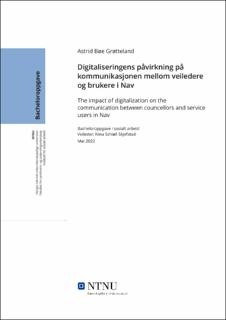| dc.contributor.advisor | Skjefstad, Nina Schiøll | |
| dc.contributor.author | Grøtteland, Astrid Bøe | |
| dc.date.accessioned | 2022-06-24T17:20:08Z | |
| dc.date.available | 2022-06-24T17:20:08Z | |
| dc.date.issued | 2022 | |
| dc.identifier | no.ntnu:inspera:111265159:37969855 | |
| dc.identifier.uri | https://hdl.handle.net/11250/3000674 | |
| dc.description.abstract | Nav har i likhet med andre offentlige tjenesteytende organisasjoner gjennomgått en omfattende digital utvikling i løpet av de siste årene. Et av områdene der digitaliseringen stiller nye krav til både veiledere og brukere er kommunikasjon over digitale kanaler. Som følge av Navs kanalstrategi skal brukere i større grad motta tjenester digitalt, slik at ressurser frigjøres på Nav-kontorene. I denne oppgaven undersøker jeg denne tematikken ut fra problemstillingen «Hvordan påvirker digitalisering kommunikasjonen mellom veiledere og brukere i Nav?». Metodisk er oppgaven en teoretisk oppgave bygget på litteratur innhentet gjennom systematiske søk. Som teoretisk rammeverk har jeg brukt Gregory Batesons kommunikasjonsteori, med særlig fokus på begrepene informasjon, kontekst, analog kommunikasjon og digital kommunikasjon. Jeg har drøftet problemstillingen ved hjelp av fire hovedtemaer: individuell tilpasning av kommunikasjonskanal, språket får ny betydning, digital teknologi som styringsverktøy og digital kompetanse som ulikhetsforsterker. I drøftingen peker jeg på at digitaliseringen i Nav endrer kommunikasjonen mellom veiledere og brukere på flere måter. Digitale plattformer utgjør en ny kontekst for kommunikasjon, noe som stiller nye krav til vurderinger og ferdigheter hos både veileder og bruker. Ved hjelp av Batesons begreper viser jeg at kommunikasjonen i større grad blir digital, og i mindre grad analog, og at dette kan medføre at det kommuniseres mer om innhold og mindre om relasjon. I tillegg er det et sentralt moment at digitaliseringen kan bidra til å forsterke eksisterende ulikheter, ved at Navs brukere i ulik grad har forutsetninger for å nyttiggjøre seg de digitale kanalene for kommunikasjon. | |
| dc.description.abstract | The Norwegian labour and welfare administration (Nav) has, together with other public service organizations, gone through an extensive digital transformation throughout the last years. The way in which counsellors and service users are expected to interact has changed extensively, which requires new skills from both groups. Because of the channel strategy introduced in Nav, the service users are supposed to receive their services through digital channels to a great extent. This is supposed to save time and resources at the local Nav offices. In this paper, I have chosen the following research question: “How does digitalization affect the communication between counsellors and service users in the Norwegian labour and welfare administration (Nav)?”. This is a theoretical paper, based on literature found through systematic literature searches. I use Gregory Bateson’s theory on communication as a theoretical framework for my analysis, and I focus especially on the concepts of information, context, analog communication and digital communication. I have discussed my research question through four main themes: choosing channel of communication, language gains new importance, digital technology as a control tool and digital competence reinforcing inequalities. In the discussion, I emphasize how the digitalization in Nav change the communication between counsellors and service users in several ways, as communication through digital channels forms an unknown context for this kind of communication. By using Batesons concepts, I show that the communication becomes more digital and less analog. Additionally, digitalization may reinforce existing inequalities, as not all service users have the same opportunities to make use of the digital channels for communication. | |
| dc.language | nob | |
| dc.publisher | NTNU | |
| dc.title | Digitaliseringens påvirkning på kommunikasjonen mellom veiledere og brukere i Nav | |
| dc.type | Bachelor thesis | |
